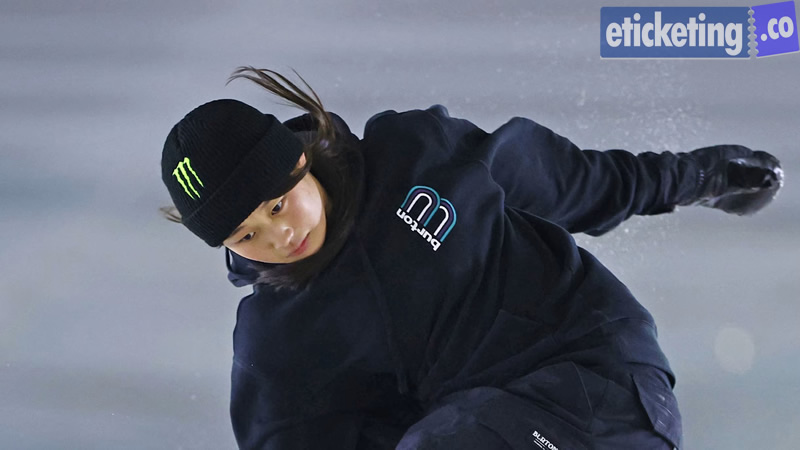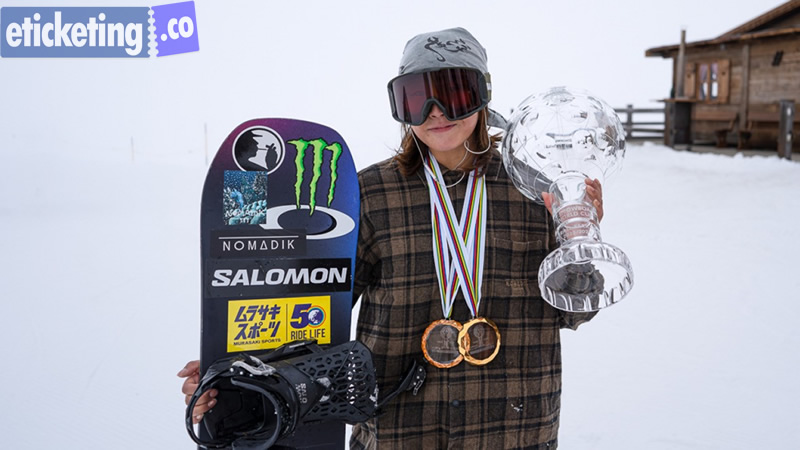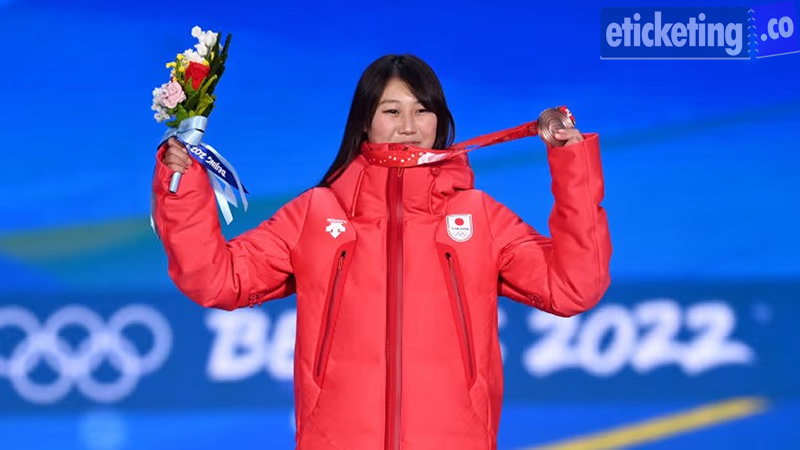In the fast-progressing world of competitive Winter Olympic snowboarding, breakthroughs are more than personal milestones—they redefine the sport. Kokomo Murase’s achievement of landing the first-ever women’s backside triple cork 1620 is exactly that kind of moment. It is a landmark that pushes the boundaries of what is physically possible and reshapes expectations heading into the Winter Olympic Milano Cortina 2026. For Murase, still only 20 years old, this accomplishment marks the culmination of years of training and a mindset built on fearless progression.
Secure your Olympic Snowboarding Tickets now at eticketing.co! Visit our website to grab your tickets at discounted rates and be part of the thrilling action in Milano Cortina 2026. Don’t miss the chance to cheer on your favorite athletes as they go for gold!

Breaking Barriers: Murase’s Triple Cork Sets a New Standard
The backside triple cork 1620—three off-axis flips paired with four and a half full rotations—is one of the most advanced tricks in the sport. It demands power, precise timing, aerial awareness, and an unwavering commitment to the landing. Few male riders have mastered it, and for years it was considered out of reach for the women’s field. Murase shattered that assumption the moment she touched down cleanly, sliding out with control and making history in the process. The Winter Olympic snowboarding world reacted instantly, recognizing that this moment would become a new benchmark for women’s freestyle progression.
Murase’s landing did not just add a trick to her resume— it redefined what will be considered competitive in the next Olympic cycle. The footage circulated globally within minutes, prompting reactions from Olympic champions, coaches, and aspiring riders. Many hailed it as one of the most important steps forward for women’s Winter Olympic snowboarding in more than a decade. Her success reflects a broader trend: women are closing the difficulty gap with unprecedented speed, fueled by improved training environments, rising talent, and a cultural shift toward embracing progression. You Can Read Jamie Anderson Returns To Olympic Snowboarding Eyes Winter Olympic 2026
Winter Olympic 2026: Training, Precision, and the Road to a Triple Cork
The achievement may have looked smooth in the final video, but it was the result of months of preparation. Executing a backside triple cork requires far more than raw skill. It involves complex athletic preparation, mental discipline, and precise technical adjustments.
Murase’s training began long before stepping onto snow. Airbag sessions allowed her to practice the rotations without risking injury. Trampoline work helped refine her axis control, while strength training built the explosive power necessary to generate height off the kicker. Each movement was studied through video analysis, breaking down body position, timing, and landing angle.

Coaches describe Murase as a deeply analytical athlete—someone who examines every detail, from wind conditions to takeoff trajectory. That meticulousness was crucial in preparing for a trick that leaves almost no room for miscalculation. But even with perfect preparation, attempting a triple cork on snow requires courage. Rotating off-axis at such speed and height can be dangerous. Murase approached the challenge with confidence built on months of consistent repetition and a belief in her ability to execute under pressure.
Technological advancements have played a major role in enabling tricks of this scale. Airbags, foam pits, and motion-analysis systems have revolutionized how riders develop new maneuvers. The environment for progression is safer, more controlled, and more precise than a decade ago. Murase has embraced these tools, using them to push herself beyond the limits that once defined women’s competition.
A Shift in Competitive Landscape Ahead of Winter Olympic 2026
Murase’s triple cork instantly transforms the strategic playbook for the upcoming Olympic cycle. As Winter Olympic Milano Cortina 2026 approaches, the world’s top riders now face a new question: is a triple cork necessary to win an Olympic medal? While the answer will depend on judging, course setup, and run composition, Murase’s trick undeniably raises the bar. In big air especially, the degree of difficulty is critical. A well-executed triple cork 1620 could become a defining element of an Olympic-winning performance.
For Murase, the challenge now turns to consistency. Landing a trick in training is different from performing it in the pressure-filled context of World Cups or the Olympic Games. She must decide whether and when to introduce the triple cork in competition. Saving it for a high-stakes event like the Olympics is a strategy athletes have used before. But bringing it out sooner could build confidence and secure a psychological edge over competitors.

Riders from countries like the United States, Austria, Canada, and New Zealand will now reassess their own preparation. Some may attempt to develop triple cork variations, knowing that difficulty plays a key role in modern judging. Others may lean into their strengths—style, switch landings, or spin combos—to stay competitive without matching Murase’s level of risk. But the sport has clearly entered a new era, and Murase is leading the way.
Inspiring the Next Generation of Riders
Beyond the competitive implications, Murase’s achievement carries cultural significance. Young snowboarders around the world saw her landing and felt a door open. For many girls, seeing another woman execute a trick of this scale can fundamentally change how they view their own potential. Representation matters deeply in action sports, and Murase’s performance adds an inspiring chapter to women’s Winter Olympic snowboarding history.
Over the past decade, the sport has witnessed a remarkable rise in female talent. Icons like Jamie Anderson and Anna Gasser helped establish new standards, and Murase now builds upon that foundation. Her triple cork pushes the ceiling higher and encourages new riders to expand their goals. It sends a clear message: progression doesn’t stop at boundaries—athletes break through them.
Sponsors, federations, and training programs are also likely to respond. Viral moments like Murase’s landing drive visibility and investment. Media outlets worldwide highlighted her breakthrough, exposing Winter Olympic snowboarding to audiences who might not otherwise follow the sport. Increased interest can lead to new funding, more development camps, and greater opportunities for youth athletes who dream of competing on the world stage.
Looking Toward Winter Olympic Milano Cortina 2026
Murase’s path to the Olympics will be carefully managed. Her coaching team will focus on maintaining her physical condition, refining her trick selection, and protecting her mental resilience. Injury prevention will be crucial, as the margin for error increases with the level of difficulty. She will also work on building versatile competition runs—combining jumps, rail sections, amplitude, and style to create complete slopestyle and big air performances.

Olympic 2026 fans worldwide can book Winter Olympic Tickets from our online platforms eticketing.co Fans can book Olympic Tickets on our website at discounted prices. Experience the thrill of the Games in Milano Cortina and support your favorite athletes as they compete for glory.
As the upcoming season approaches, fans will watch closely to see how Murase incorporates the triple cork into her competitive strategies. Will she unveil it at X Games? Will she save it for an Olympic moment? Or could she push progression further by experimenting with new variations? Whatever she decides, the world will be watching. Winter Olympic Snowboarding thrives on evolution, and Murase has become the face of that movement.
A Defining Moment: Murase Redefines Women’s Winter Olympic Snowboarding
Kokomo Murase’s backside triple cork 1620 is more than a trick—it is a statement. It represents the courage to attempt what has never been done, the discipline to train relentlessly, and the vision to imagine a new future for women’s Winter Olympic snowboarding. This moment will be remembered as a turning point, a leap forward that reshaped expectations heading into Winter Olympic Milano Cortina 2026.

As the Olympic cycle accelerates, Murase stands poised to redefine her sport once again. Fearless, innovative, and driven, she embodies the spirit of progression. Her historic achievement proves that the boundaries of Winter Olympic snowboarding are still expanding—and that she is the athlete leading that evolution.
Experience the magic and excitement as fans from around the world gather to celebrate the spirit of the Games. Secure your Olympic Opening Ceremony Tickets now and create memories that will last a lifetime at the unforgettable Winter Olympic 2026.
